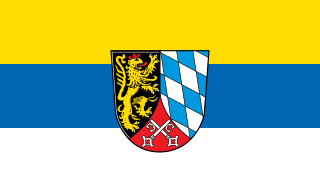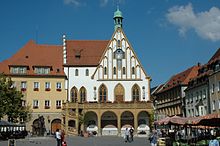
Bavaria, officially the Free State of Bavaria, is a state in the southeast of Germany. With an area of 70,550.19 km2 (27,239.58 sq mi), it is the largest German state by land area, comprising roughly a fifth of the total land area of Germany, and with over 13.08 million inhabitants, it is the second most populous German state, behind only North Rhine-Westphalia; however, due to its large land area, its population density is below the German average. Major cities include Munich, Nuremberg, and Augsburg.

Regensburg is a city in eastern Bavaria, at the confluence of the Danube, Naab and Regen rivers, Danube's northernmost point. It is the capital of the Upper Palatinate subregion of the state. With more than 150,000 inhabitants, Regensburg is the fourth-largest city in the State of Bavaria after Munich, Nuremberg and Augsburg and the 8th largest of all cities on the Danube river. From its foundation as an imperial Roman river fort, the city has been the political, economic and cultural centre of the surrounding region. Later, under the rule of the Holy Roman Empire, it housed the Perpetual Diet of Regensburg.

The Upper Palatinate is an administrative district in the east of Bavaria, Germany. It consists of seven districts and 226 municipalities, including three cities.

Hirschau is a municipality in the Amberg-Sulzbach district, Upper Palatinate, Bavaria, Germany.

Schwandorf is a town on the river Naab in the Upper Palatinate, Bavaria, Germany, which is the seat of the Schwandorf district. Schwandorf is a Family-friendly community.

Horst Lorenz Seehofer is a German politician who served as Minister for the Interior, Building and Community under Chancellor Angela Merkel from 2018 to 2021. A member of the Christian Social Union (CSU), he served as the 18th minister-president of Bavaria from 2008 to 2018 and Leader of the Christian Social Union in Bavaria from 2008 to 2019.

Altenthann is a village and municipality in the district of Regensburg in Bavaria in Germany.

CDU/CSU, unofficially the Union parties or the Union, is a centre-right Christian democratic and conservative political alliance of two political parties in Germany: the Christian Democratic Union of Germany (CDU) and the Christian Social Union in Bavaria (CSU).
Bavaria, one of the states of Germany, has a multiparty system dominated by the Christian Social Union in Bavaria (CSU). Bavaria has long been a bastion of conservative politics in Germany, with the Christian Social Union has won every election of the state parliament since 1946 and having almost a monopoly on power. Every Minister-President since 1957 has been a member of this party. On the other hand the bigger and more liberal, or rather social democratic, cities, especially Munich, have been governed for decades by the Social Democratic Party of Germany (SPD) until recently the second biggest party. In 2018 the Alliance 90/The Greens which have been represented in the state parliament since 1986, became the second biggest political party in the Landtag and in 2020 the biggest party in the Munich City Council. From the historical point of view, older Bavaria was one of the most liberal, predominantly Roman Catholic states until the rather rural areas of Swabia and Franconia were added in 1814/15 at the Congress of Vienna.
The Royal Bavarian Eastern Railway Company or Bavarian Ostbahn was founded in 1856. Within just two decades it built an extensive railway network in the eastern Bavarian provinces of Upper Palatinate (Oberpfalz) and Lower Bavaria (Niederbayern) that had previously been largely undisturbed by the railway. Much of this network is still important for local and long distance rail traffic operated by the Deutsche Bahn today.
Reichsbahndirektion Regensburg was a Deutsche Reichsbahn railway division within the Bavarian Group Administration in southern Germany with its headquarters at Regensburg, Bavaria.

Margaret of Bavaria was a princess of Bavaria-Landshut and by marriage Princess of the Palatinate.
Franz Xaver von Schönwerth was a Bavarian civil servant who was an important collector of folklore in the Upper Palatinate region.

Melanie Huml is a German physician and politician of the Christian Social Union of Bavaria (CSU) who has been serving as State Minister for European and International Affairs in the cabinet of Minister-President Markus Söder since 2021. She has been a member of the Landtag of Bavaria since October 2003.

Philipp Graf von und zu Lerchenfeld was a German politician for the Christian Social Union in Bavaria (CSU). He worked in both regional and national politics, most notably being member of the Landtag of Bavaria from 2003 to 2013 and then serving as a member of the Bundestag from 2013 to 2017.

Ursula Männle is a German Social sciences academic and politician (CSU). She served between 1983 and 1994 as a member of the Bundestag. More recently, between 2000 and 2013, she was a member of the Bavarian Landtag, chairing an important parliamentary committee and, till 2009, chairing the women's working group in the Landtag.

Astrid Freudenstein is a German civil servant and politician of the Christian Social Union in Bavaria (CSU).

The Regensburg satellite camp, also known as the Colosseum subcamp in the vernacular at the time, was established in 1945 as the last subcamp of the Flossenbürg concentration camp in the Regensburg inn the Kolosseum. The Regensburg subcamp was in operation from March 19, 1945, until April 23, 1945. The Colosseum building is located at Stadtamhof 5, approximately 200 meters north of the Danube across the Stone Bridge from the Altstadt.
Susanne Hierl is a German lawyer and politician of the Christian Social Union (CSU) who has been serving as a member of the Bundestag since the 2021 elections, representing the Amberg constituency.





















